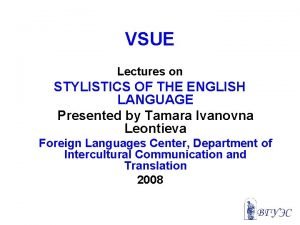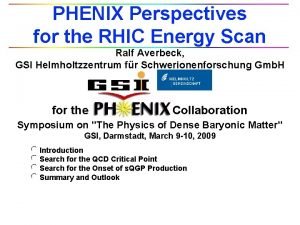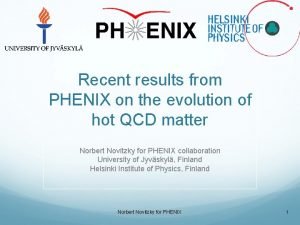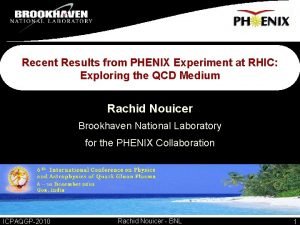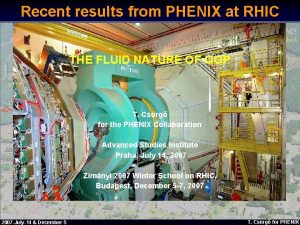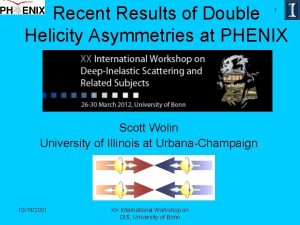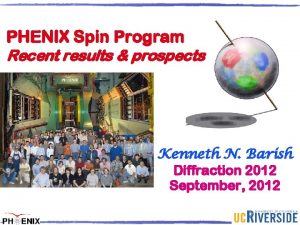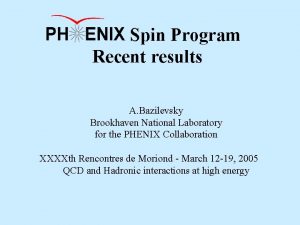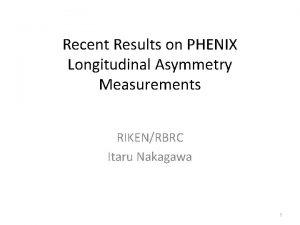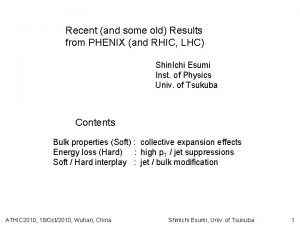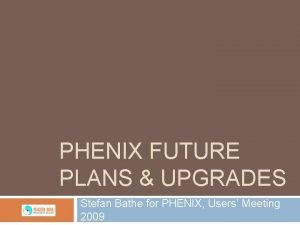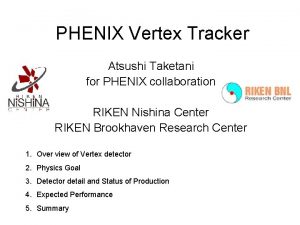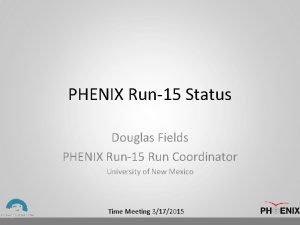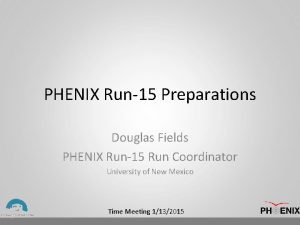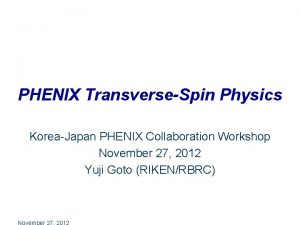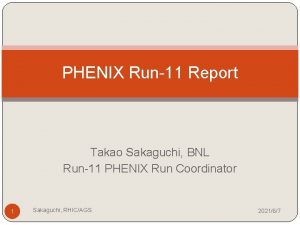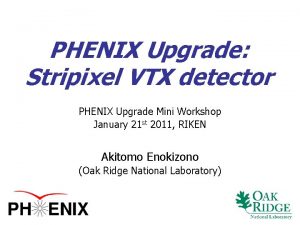Recent results from PHENIX on the evolution of






























- Slides: 30

Recent results from PHENIX on the evolution of hot QCD matter Norbert Novitzky for PHENIX collaboration University of Jyväskylä, Finland Helsinki Institute of Physics, Finland Norbert Novitzky for PHENIX 1

PHENIX @ RHIC PHENIX: Pioneering High Energy Nuclear Interaction e. Xperiment The Relativistic Heavy Ion Collider (RHIC): • The beam species: p – Cu – Au – U • Heavy ion collisions 7. 7 -200 Ge. V • Asymmetric collisions • Polarization of proton beams Measured: • p+p @ 62. 4 - 510 Ge. V (polarized) • Au+Au @ 7. 7 - 200 Ge. V • Cu+Cu @ 22. 4 - 200 Ge. V • d+Au @ 200 Ge. V • U+U @ 193 Ge. V • Cu+Au @ 200 Ge. V Norbert Novitzky for PHENIX 2

PHENIX detector Photons, neutral pion p 0 e+e- pairs E/p and RICH Calorimeter e- e+ PC 1 DC magnetic field & tracking detectors Norbert Novitzky for PHENIX 3

Little Big Bang quark Time: fraction of fm/c: order of one fm/c Proces s: Hard scattering Thermalization Jet quenching High temperatures several fm/c Expansion Collective motion QGP probe Opacity Norbert Novitzky for PHENIX Luminosity Fluidity 4

Little Big Bang quark Time: fraction of fm/c: order of one fm/c Proces s: Hard scattering Thermalization Jet quenching High temperatures several fm/c Expansion Collective motion QGP probe Opacity Norbert Novitzky for PHENIX Luminosity Fluidity 5

Parton Energy Loss Hard parton propagating through excited QGP: Medium-induced gluon Essentially four categories: bremsstrahlung. – Opacity expansion (GLV) : Gyulassy, Levai, . Vitev, PLB 538, 2002 – Multiple soft scattering (BDMPS-Z-ASW) : Wiedemann, NPB 588, 2000 – Higher-twist (HT): Guo, Wang, PRL. 85, 3591, 2000 – Thermal field theory (AMY): Arnold, Moore, Yaffe, JHEP 11, 001(2000) All models: Models successfully describe the rate and p. T dependence of the jet quenching. Large systematic uncertainties e. g. [Phys. Rev. , 2010, C 81, 024909] Testing against multiple observables is essential to test physics of the Norbert Novitzky for PHENIX models 6

Nuclear modification factor A+A p+p Norbert Novitzky for PHENIX varies with impact parameter b 7

Motivation – Low Energy Scan x 5 No suppression of particles was Large suppression of particles observed in d+Au collisions at was observed (up to factor of 5) in √s. NN = 200 Ge. V Au+Au collisions at √s. NN = 200 Ge. V Convincing evidence for the final state partonic interaction - emergence of s. QGP Where the suppression starts to dominate? How the suppression depends on p. T, system size, √s. NN? Norbert Novitzky for PHENIX 8

RAA in energy scan ar. Xiv: 1204. 1526 v 1 p. T dependence: • 39 Ge. V shows strong suppression in the most central collision. • The 62. 4 and 200 Ge. V RAA data points are comparable Centrality dependence: • In mid-peripheral collision, 39 Ge. V no suppression, 62. 4 -200 Ge. V Theory: suppressed • GLV model calculations are showing similar trend, but not fitting the data well. (two calculation with gluon mean free path +30%) Norbert Novitzky for PHENIX 9

RAA in averaged over p. T ar. Xiv: 1204. 1526 v 1 RAA in different √s. NN: • 62. 4 -200 Ge. V are strongly suppressed • 39. 0 Ge. V data shows suppression for higher centrality only (Npart>100) • For p. T > 6 Ge. V/c the 62. 4 and 200 Ge. V data points are comparable The suppression is most significant in most central collisions and it disappears earlier in lower √s. NN Norbert Novitzky for PHENIX 10

Opacity – Summary �Reaching high enough collision energy we create an opaque medium for partons �RAA measured in Au+Au and d+Au collisions shows the suppression is final state effect �The opacity evolves as function of centrality, √s. NN, p. T �An opaque medium is created in 39 Ge. V collision, but the opaqueness disappears in lower centralities Norbert Novitzky for PHENIX 11

Little Big Bang quark Time: fraction of fm/c: order of one fm/c Proces s: Hard scattering Thermalization Jet quenching High temperatures several fm/c Expansion Collective motion QGP probe Opacity Norbert Novitzky for PHENIX Luminosity Fluidity 12

Nuclear Geometry and Hydrodynamic flow thermalizatio n larger pressure gradient in plane Reaction Plane less yield out more in plane RP z y x Initial geometry has multiple shape components due to fluctuations. Norbert Novitzky for PHENIX 13

Motivation – Low Energy Scan The hydrodynamical flow of particles were measured in large range of collision energy. • From few Ge. V up to few Te. V Hydrodynamical flow in √s. NN: • Results follows the global trend for averaged v 2 • Flow seems to saturate √s. NN > 100 -200 Ge. V - indicates ideal "hydro". Evolution between SPS and RHIC energies - same trend ? Norbert Novitzky for PHENIX 14

vn as a function of p. T in Energy Scan � Various beam energy: 39, 62, 200 Ge. V � No significant beam energy dependence within uncertainties Norbert Novitzky for PHENIX � vn follows expected behavior down to 39 Ge. V 15

vn as a function of centrality � Various beam energy: 39, 62, 200 Ge. V � Increasing flow towards more peripheral collisions � Averaged vn follows also expected behavior Norbert Novitzky for PHENIX 16

Fluidity – Summary �The plasma created in heavy ion collisions has hydrodynamical behavior �The flow is depending on initial geometry of the collision �vn shows the same behavior in collisions of Au+Au at √s. NN = 39 – 200 Ge. V �Flow follow the expected behavior in √s. NN Norbert Novitzky for PHENIX 17

Little Big Bang quark Time: fraction of fm/c: order of one fm/c Proces s: Hard scattering Thermalization Jet quenching High temperatures several fm/c Expansion Collective motion QGP probe Opacity Norbert Novitzky for PHENIX Luminosity Fluidity 18

Schematic View of Thermal Photons � Longitudinally and radially expanding fire ball in “local equilibrium” � Real and virtual photons � Integrated over space-time � Local equilibrium: � Real and virtual photon momentum spectrum � Temperature information � sensitive to early times due to e-w/T � Collective expansion, w = pmum � Radial expansion results in blue and red shift � Longitudinal expansion results in red shift Hadron Gas Thermal Tf QGP Thermal Ti “Pre-Equilibrium”? Jet Re-interaction Hard Prompt E Norbert Novitzky for PHENIX 19

Photons , * from A+A Direct Non-thermal Thermal Quark-Gluon Plasma Hadron Gas p p r Hadron gas QGP Preequilibrium “Prompt” hard scattering Production of photons: g q q What is the ratio for HG/QGP production? Need to subtract decay photons Hadron Decays 107 log Norbert Novitzky for PHENIX Sensitive to space-time evolution 20

Prompt Photon in Au+Au PHENIX ar. Xiv: 1205. 5533 PHENIX photon data High p. T (4 to 25 Ge. V) from calorimeter Nuclear Modification Factor Consistent with binary scaling of p+p No evidence for cold nuclear matter or hot medium effects out to 20 Ge. V/c Hard scattering × Ncoll describes prompt from Au+Au for p. T above 5 Ge. V/c Norbert Novitzky for PHENIX ar. Xiv: 1205. 5533 21

Thermal Photon in Au+Au PHENIX Phys. Rev. C 81 (2010) 034911 * (m→ 0) = ; m << p. T � Direct photons from real photons: � Measure inclusive photons and subtract decay photons T ~ 220 Me. V � Direct photons from virtual photons: Hydro calculation: * (m 0) p. QCD Inclusive photon spectra: Exponential – temperature � Measure e+e- pairs at mp < m << p. T time First thermal photon measurement: Tini > 220 Me. V > TC Norbert Novitzky for PHENIX Need to consider radial flow! Compare to models! 22

Thermal photon v 2 photon conversions →e+e PHENIX preliminary Independent analysis based on photon conversions →e+e ar. Xiv: 1105: 4126 � Background free inclusive photon sample reaction plan: 1< |h|<2. 8 � R from same data � Completely independent Au+Au 200 Ge. V min. bias systematic uncertainties � p. T reach extended down to 0. 5 Ge. V/c Large elliptic flow of thermal photons Maximum v 2~ 0. 2 at 2 Ge. V/c � Two independent and consistent Norbert Novitzky for PHENIX results! 23

Thermal photon Puzzle Models fail to describe simultaneously photon yield, T and v 2! Tini ~ 325 Me. V Hees/Gale/Rapp Phys. Rev. C 84: 054906, 2011. R. Chatterjee and D. K. Srivastava PRC 79, 021901(R) (2009) PRL 96, 202302 (2006) Large flow requires late emission! Apparent contradiction with yield, which points towards early emission! Norbert Novitzky for PHENIX 24

Photons – Summary �Photon spectrum was measured at √s. NN = 200 Ge. V �Thermal photons were measured by PHENIX �Thermal photon puzzle: � Two independent measurements were done to determine the v 2 of photons � Theory cannot explain yet the high yield and high flow of thermal photons Norbert Novitzky for PHENIX 25

THANK YOU Norbert Novitzky for PHENIX 26

Backup Norbert Novitzky for PHENIX 27

Elliptic flow of Photons � How to determine elliptic flow of thermal photons? � � Establish R , i. e. fraction of thermal photons in inclusive photon yield Measure inclusive photon v 2 incl Predict hadron decay photon v 2 hadr from pion v 2 p 0 Subtract hadron decay contribution PHENIX ar. Xiv: 1105. 4126 Large v of low p thermal photon Norbert Novitzky 2 for PHENIX T 28

Thermal Photons � PHENIX has developed new method to detect direct photons: � Use photon conversions to e+e � Tag contribution from p 0 decays � Independent systematic uncertainties conditional tagging efficiency measured raw yields simulated based On hadron data Thermal photons observed in virtual and real photons consistent within uncertainties Norbert Novitzkysystematic for PHENIX 29

Prompt Photon in p+p and d+Au � PHENIX photon data � High p. T (4 to 25 Ge. V) from calorimeter � Low p. T (<4 Ge. V) from virtual photons � p+p data consistent with p. QCD � x. T scaling of cross section � NLO calculation agree well with data � d+Au data consistent with Ncoll scaling � No evidence for cold nuclear matter effects PHENIX ar. Xiv: 1205. 5533 Well established reference for prompt photons Norbert Novitzky for PHENIX 30
 A friend emails you the results of a recent high school
A friend emails you the results of a recent high school Phoenix scan
Phoenix scan Le phenix de la famille meaning
Le phenix de la famille meaning Jargonisms are
Jargonisms are Phenix scan
Phenix scan Recent amendments in companies act
Recent amendments in companies act Current trends in project management
Current trends in project management Recent advances in ceramics
Recent advances in ceramics Is college worth it synthesis essay
Is college worth it synthesis essay Emerging trends in mis
Emerging trends in mis Recent demographic changes in the uk
Recent demographic changes in the uk Recent trends in ic engine
Recent trends in ic engine Passive voice in the news
Passive voice in the news Trends in india foreign trade
Trends in india foreign trade Mpgu
Mpgu Myips.schoology.com
Myips.schoology.com Recent developments in ict
Recent developments in ict Http drive google com
Http drive google com Conclusion of skimming and scanning
Conclusion of skimming and scanning Biotaphonomy
Biotaphonomy After a skydiving accident laurie
After a skydiving accident laurie Recent developments in object detection
Recent developments in object detection Khi nào hổ con có thể sống độc lập
Khi nào hổ con có thể sống độc lập Thiếu nhi thế giới liên hoan
Thiếu nhi thế giới liên hoan điện thế nghỉ
điện thế nghỉ Một số thể thơ truyền thống
Một số thể thơ truyền thống Trời xanh đây là của chúng ta thể thơ
Trời xanh đây là của chúng ta thể thơ Ng-html
Ng-html Số nguyên tố là gì
Số nguyên tố là gì Fecboak
Fecboak đặc điểm cơ thể của người tối cổ
đặc điểm cơ thể của người tối cổ


